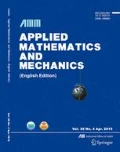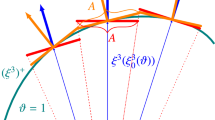Abstract
By coupling natural boundary element method (NBEM) with FEM based on domain decomposition, the torsion problem of the square cross-sections bar with cracks have been studied, the stresses of the nodes of the cross-sections and the stress intensity factors have been calculated, and some distribution pictures of the stresses have been drawn. During computing, the effect of the relaxed factors to the convergence speed of the iterative method has been discussed. The results of the computation have confirmed the advantages of the NBEM and its coupling with the FEM.
Similar content being viewed by others
References
YU De-hao.The Methematical Theory of Natural Boundary Element Method [M]. Beijing: Science Press, 1993. (in Chinese)
YU De-hao. Discretization of non-overlapping domain decomposition method for unbounded domain and its convergence [J].Computational Mathematics, 1994,6(4):448–459. (in Chinese)
YU De-hao. A domain decomposition method based on the natural boundary reduction over unbounded domain [J].Computational Mathematics, 1996,18(3):328–336. (in Chinese)
DONG Zheng-zhu, ZHAO Hui-ming, CAO Ying-luo. On the torsion problem of the sector cross-section bar [J].Journal of China University of Mining and Technology, 1997,26(3):105–109. (in Chinese)
ZHAO Hui-ming. Natrual boundary element method and its application in mechanics [D]. Master Thesis. Xuzhou: China University of Mining and Technology, 1997. (in Chinese)
TANG Ren-ji.The Torsion Theory of Cracked Cyclinder [M]. Shanghai: Shanghai Jiaotong University Press, 1996. (in Chinese)
XU Zhi-lun.Elastical Mechanics [M]. Beijing: High Education Press, 1994. (in Chinese)
LÜ Tao, SHI Ji-min, LIN Zhen-bao.The Algorithm of Domain Decomposition [M]. Beijing: Science Press, 1992. (in Chinese)
ZHUO Jia-shou.The FEM in Elastical Mechanics. [M]. Beijing: Higher Education Press, 1984. (in Chinese)
CUI Zhen-yuan, CHEN Yi-zhou. A boundary collocation technique for evaluation the torsional rigidity and third stress intensity factors of cracked bars [J].Acta Solid Mechanica Sinica, 1981,2(4):503–511. (in Chinese)
Author information
Authors and Affiliations
Additional information
Communicated by DING Hao-jiang
Foundation item: the State Key Laboratory of Science and Engineering Computation
Biography: ZHAO Hui-ming (1971-)
Rights and permissions
About this article
Cite this article
Hui-ming, Z., Zheng-zhu, D. & Ying-luo, C. The coupling method for torsion problem of the square cross-section bar with cracks. Appl Math Mech 21, 1308–1313 (2000). https://doi.org/10.1007/BF02459253
Received:
Revised:
Issue Date:
DOI: https://doi.org/10.1007/BF02459253




